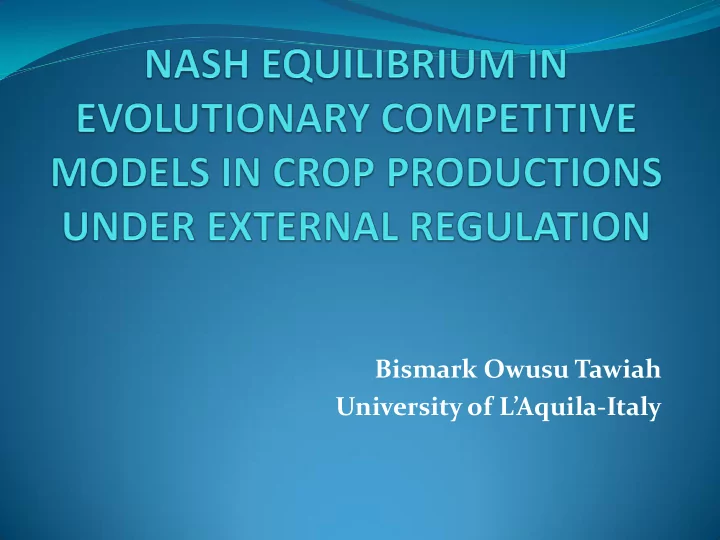

Bismark Owusu Tawiah University of L’Aquila -Italy
OVERVIEW Introduction Competitive Model between Farmers and Agro- Companies Competitive Model with External Regulator Discussion
INTRODUCTION The paper present a first non-cooperative model between agro-Companies and farmers where a poverty trap is identified. Starting from a non-innovative economy, innovative agro-Companies cannot support their strategy, since their incomes are discouraging. The main characteristic of this model is that the poverty trap is a Nash equilibria, stable in an evolutionary viewpoint and Pareto-in efficient.
The goal is to mathematically understand and fully characterize poverty traps, find alternative global optimum in the overall strategy-space and promote the economy such that all the three players farmers, Agro- Companies and the external regulator maximizes income The external regulator, in a Two-phase process (loans, taxes) achieves a common wealth, with a prosperous economy, with innovative and skilled Cocoa farmers
Poverty Trap Definition : A poverty trap is any self-reinforcing mechanism that endures poverty.
Poverty Trap
Crucial questions Why is the poverty trap recurrent despite production each year? And is there any scenario in which greater income can be attained by all players enhancing the growth of the economy which is consistent with poverty reduction?
Competitive model between Farmers and Agro-Companies Game in normal form : Players : Farmers Strategies: Companies Strategies:
Economic parameters
Economic parameters
Assumptions
Incomes
Incomes
Constraints
Nash Equilibrium
Mixed Strategies & Expected Income
Pareto Equilibrium
Mixed Strategies
Competitive model with external regulator Game with external :
Income
Expected Income
Dynamics under Normal Game
Dynamics under Loan for Game(E)
Dynamics under Tax for Game(E)
Conclusion
References [1]. Models of Poverty and Planned Change: A Framework for Synthesis, . Journal of Sociology and Social Welfare, Vol. V, No. 3 (May 1976), 316-325. [2] E. Accinelli, S. London, L. F. Punzo and E. J. S. Carrera, Poverty traps, rationality and evolution, Dynamics, Games and Science I , 1 (2011),3752. [3] ] E. Accinelli, S. London and E. Sanchez, A model of imitative behavior in the population of firms and workers, Technical Report, Department of Economics, University of Siena, 2009. [4] C. Azariadis and J. Stachurski, Chapter 5 poverty traps, in Handbook of Economic Growth, Vol. 1 (eds. P. Aghion and S. Durlauf), 2005, 295384.
References [5] ] C. B. Barrett and B. M. Swallow, Fractal poverty traps, World Development, 34 (2006),115 [6] J. Nash, Non-cooperative games, The Annals of Mathematics, 54 (1951), 286295.
Recommend
More recommend